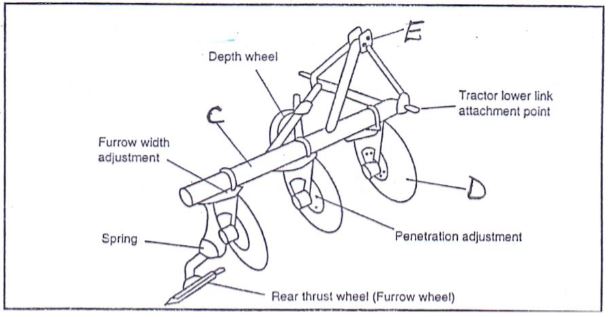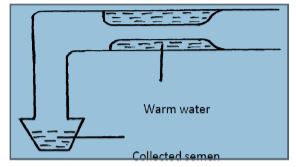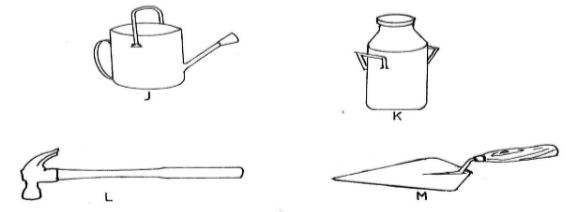Questions
INSTRUCTIONS TO THE CANDIDATE
- This paper consists of three sections A, B, and C
- Answer all the questions in section A and B
- Answer any two questions in section C
SECTION A 30 MARKS (answer all questions in this section)
- What is apiculture (1 mark)
- Name one livestock disease that is transmitted by the following parasites.
- Brown ear tick (½ mark)
- Tsetse fly (½ mark)
- State the intermediate host for liver fluke Fasciola spp. (½ mark)
- State four breeds of rabbits. (2 marks)
- State two functions of a crop in a digestive system of chicken. (1 mark)
- State three ways of restraining cattle (1½ marks)
- State two functions of the walking area in a zero grazing unit (1 mark)
- State two methods of selecting animals for breeding (1 mark)
- State four maintenance’s carried out in a fish pond. (2mark)
- State three functions of feed additives in livestock production. (1 ½ marks)
- State two types of calf pens. (1 mark)
- State four advantages of castrating male goats (2 marks).
- State two roles of the damp proof course in the foundation of a building (1mark)
- Differentiate between mothering ability and prolificacy (2 marks)
- State four routes in which pathogens gets into the body of livestock (2 marks)
- State four factors that determine the quality of honey (2marks)
- State four advantages of artificial calf rearing in dairy cattle management (2marks)
- State four functions of the lubricating system in a tractor (2mks)
- What are the factors to consider in grading eggs for marketing (2marks)
- State three channels through which kenyan beef farmers market their products (1 ½ marks)
SECTION B 20 MARKS ( answer all questions in this section)
- Below shows part of a farm implement study it and answer questions that follow
- Identify the implement ( ½ mark)
- identify parts labeled C,D and E (1 ½ marks)
- State three reasons why the implement is better in land preparation (3marks)
- The following is diagrams of an artificial incubator study it and answer questions that follow
- Name the parts labeled A and B (2mark)
- Explain three conditions that are necessary for a successful hatching. (3 marks)
- The diagram below shows a livestock production equipment study it and answer questions that follow
- Identify the equipment (1mark)
- What is the importance of warm water in the equipment (1mark)
- State the procedure followed when using the equipment in collecting semen (3marks)
- Below shows various farm tools and equipment used in the farm study them and answer questions that follow
- Identify tools J, K, L and M (2marks)
- State the function of tool L and M (2marks)
- State two maintenance’s of tool k (1mark)
SECTION C (40 MARKS) (answer two questions in this section)
- describe nine uses of fences in the farm (9marks)
- Highlight five reasons for maintaining farm tools and equipment in the farm (5marks)
- Describe six effects of parasites on livestock (6marks)
-
- describe the causes of cannibalism in poultry (6marks)
- Outline general control measures of livestock diseases (10mks)
- Outline four essentials for clean milk production (4marks)
-
- describe Newcastle under the following subheading
- Causal organism (1mark)
- Signs of infection (6marks)
- Control measures (3marks)
- Describe five activities that take place during the digestion process in the rumen (5marks)
- Outline the general characteristics of dairy cattle (5marks)
- describe Newcastle under the following subheading
Marking Scheme
- Apiculture- This involves the rearing of bees in structures known as beehives
( 1x1 =1mark) -
- Brown ear tick-east coast fever and red water. (1x ½ = ½ mark)
- Tsetse fly- trypanasomiasis. (1x ½ = ½ mark)
- Intermediate host for liver fluke- mud/water snail (reject snail alone) (1x ½ = ½ mark)
- Four rabbit breeds (4x ½ =2marks)
- Californian white:
- New Zealand white:
- Flemish giant
- Angora rabbit
- Chinchilla
- Ear lops.Kenya white
- Function of the crop (2x ½ =1mark)
- Storage of food.
- Softening of food by secretions from small glands in the walls.
- Ways of restraining animals animals (3x ½ = 1 ½ marks)
- Ropes,
- Halters,
- Lead stick and bull rings
- Head yoke
- Crush
- Function of walking area in zero grazing unit (2x ½ =1mark)
- Dunging
- Resting
- Sunning
- Methods of selecting animals (2x ½ =1mark)
- Mass selection
- Contemporary comparison
- Progeny testing
- Maintenance’s of a fish pond (4x ½ =2marks)
- Maintaining good level of water
- Cleaning the pond to remove foreign particles and other organisms
- Keeping off predators by fencing properly
- Removal of unnecessary vegetation all weeding
- Planting grass where necessary to prevent soil erosion
- Functions of feed additives (3x ½ = 3marks)
- Stimulate growth and production.
- Improve feed efficiency.
- Prevent disease causing organisms.
- Types of calf pens (2x ½ =1mark)
- Raised permanent pens
- Permanent calf pens with concrete floors
- Mobile calf pens
- Reason for castrating male goats (4x ½ =2marks)
- To control breeding diseases.
- To control breeding.
- For faster growth rates.
- Increase quality of meat by removing unpleasant smell especially in goats.
- Functions of a damp proof course ( 2x1= 1mark)
- Reduce termite attack
- Prevent moisture rising up the wall
- Difference between mothering ability and prolificacy (1x1=1mark)
- Mothering ability is having good natural good instincts to the young ones while prolificacy is the ability of giving birth to many offspring’s at a time.
- routes in which pathogens gets into the body of livestock
Through the- Mouth
- Eyes
- Nose
- Genital openings
- Wounds (4x ½ =2mks)
- Factors determining quality of honey (4x ½ = 2marks)
- Type of plant from which nectar was obtained
- Maturity stage of honey at time of harvest
- Method of harvesting
- Method of processing honey
- Advantages of artificial calf feeding (4x ½ = 2marks)
- Easy to keep accurate production record/milk yields of the cow.
- Possible to regulate the amount of milk given to the calf
- The cow does not need the presence of the calf in order to let down milk
- Easy to maintain high hygiene standards.
- There is a likelihood of the farmer selling more milk
- Many calves can be raised at the same time
- Orphaned calves can be raised successfully
- Functions of lubrication system. (4x ½ = 2marks)
- It helps to increase the efficiency of the machine and
- Reduces the rate of wear and tear of moving parts.
- It reduces the heat created by the rubbing surfaces and acts as a seal between them.
- It acts as a cleaning agent because it washes off all the dust, dirt, and soot and metal chippings from the oil paths to the sump.
- Factors to consider when grading eggs. (4x ½ =2marks)
- Size/weight of the egg - large eggs fetch high prices than small ones. The average weight should be about 57gms.
- Shape of the egg - The normal egg shape is oval, with a broad end and a narrow end.
- Cleanliness - Consumers prefer clean eggs.
- Colours of the shell - Brown eggs are popular with the consumers.
- Candling qualities - candling is done to determine freshness of the eggs and presence of any other egg abnormalities.
- Shell texture- should be smooth and without cracks.
- Channels that beef farmers market their products (3x ½ =1 ½ marks)
- Individual farmers through the local slaughter house.
- Livestock marketing division.
- Kenya Meat Commission.
- Farmer's Choice.
-
- disc plough (1x ½ = ½ mark)
- C- beam ( ½ mark each)
D- Concave disc
E- Top link attachment - Can be used in fields with obstacles because it roles over obstacles
It is not easily broken by obstacles because it rides over
It requires less power to pull when operating (3x1= 3marks)
-
- A- thermometer (1mark each)
B- Warm water - Temperature of between 37.5-39.4 degrees Celsius throughout to control the rate of embryonic development of the chick. High or low temperatures are lethal.
Fresh air/ ventilation- Good air circulation.
Relative humidity - Maintained at 60%.
High humidity leads to marshy chicks
low humidity the chick may stick to the shell.
Egg turning Done 3-4 times a day to facilitate uniform distribution of heat for uniform development of chick.
Cleanliness - cleaning and disinfecting the incubator with formaldehyde solution. (State ½ , explain ½ )
- A- thermometer (1mark each)
-
- artificial vagina (1x1=1mark)
- Warm water stimulates the penis to ejaculate/release semen (1x1=1mark)
- A cow is restrained in a crush
A bull is brought to the teaser cow when the bull mounts on the teaser cow a person grabs it and directs it into the artificial vagina
Since the vagina contains warm water the bull is stimulated and it releases semen which is collected (3x1=3marks)
-
- tools ( 4x ½ =2marks)
J- Watering can
K-Milk churn (rej milking churn)
L- Claw hammer
M-masons trowel - L- for storing of milk
For transporting milk
M- Laying on of mortar during construction ( 2x1=2marks) - Clean and disinfect after use
Store properly in a tool store (2x ½ =1mark)
- tools ( 4x ½ =2marks)
-
- Importance of Fence in a Farm
- Keep out intruders to the farm,
- Define the boundary lines of the farm.
- Paddocking of fields to make rotational grazing possible.
- Live fences serve as windbreaks.
- Fences are used in mixed farming to protect crops from. Damage by livestock.
- Fences add aesthetic values to the farm.
- It is easy to control breeding.
- It is easy to isolate sick animals from the rest of the herd. (9x1=9marks)
- Reasons for Maintenance of tools
- To increase durability.
- To increase efficiency.
- Reduce costs of replacement.
- For safety of the user/avoid accidents.
- Avoid damage to the tool (5x1=5marks)
- The effects of parasite on the host animal are:
- Depriving the host of its food.
- Sucking blood.
- Damaging the organs of the host.
- Cause irritation on the skin of the host.
- Destruction of hides and skins.
- Transmission of diseases.
- Cause obstruction in body passages. ( 6x1=6marks_)
- Importance of Fence in a Farm
-
- Causes of Cannibalism
- Overcrowding in the house.
- High temperatures in the poultry house making the birds uncomfortable.
- Too bright light.
- External parasite infestation.
- Inadequate and incorrect feeding.
- Idleness of the birds.
- Greediness of the birds.
- Disturbances of the pecking order
- Prolapses of the rectum which occurs once in a while.
- Bright light in the lying boxes. (6x1= 6mks)
- General Methods of Disease Control
- Quarantine.
- Vaccination.
- Control of vectors by use of acaricides and rotational grazing.
- Disinfecting the equipment and buildings.
- Use of preventive drugs.
- Proper feeding of livestock.
- Culling of the animals which are carriers/slaughtering the affected animals.
- Use of artificial insemination to control breeding diseases.
- Proper selection and breeding of animals.
- Proper housing and hygiene,
- Isolating sick animals. ( 10x1=10 marks)
- The following factors are essential for clean milk production:
- A healthy lactating cow
- A healthy and clean milker.
- Clean and properly constructed milking parlour.
- Clean and disinfected milking equipment.
- Proper handling of the milk after milking. ( 4x1=4marks)
- Causes of Cannibalism
-
-
- New Castle - Cause: Virus. (1x1=1mark)
- Symptoms
- Difficulties in breathing.
- Beaks remain wide open and necks are strained.
- Birds become dull.
- The birds stand with eyes closed all the time.
- Anorexia/loss of appetite.
- Nasal discharges which force the birds to shake their heads to clear it.
- Birds walk with a staggering motion.
- Paralysis of wings and legs may occur.
- Birds have their beaks and wings down.
- Birds produce watery greenish diarrhea.
- Birds lay soft shelled eggs. ( 6x1=6marks)
- Control
- Killing all birds and burning them followed by cleaning and disinfecting the houses before bringing in new stock.
- Vaccination should be done during the first 6 weeks and then 2-3 months later.
- Quarantine ( 3x1=3marks)
- Activities that take place in the Rumen-
- Breakdown of food by micro-organisms and also stores food.
- Synthesis of vitamin B-complex.
- Synthesis of amino acids from ammonia gas.
- Proteins are broken to peptides and amino acids.
- Carbohydrates are broken to volatile fatty acids. ( 5x1=5marks)
- Characteristics of Dairy Cattle
- Wedge or triangular in shape.
- Large stomach.
- Docile with mild temperament.
- Large, well suspended udders and teats.
- Lean bodies.
- Lean and smooth neck.
- Large and long mammary milk wells and veins.
- Cylindrical; uniform and well-spaced teats.
- Wide and well set hindquarters to accommodate the udder. (5x1=5marks)
-
Download Agriculture Paper 2 Questions and Answers - Mathioya Mock Exams 2022.
Tap Here to Download for 50/-
Get on WhatsApp for 50/-
Why download?
- ✔ To read offline at any time.
- ✔ To Print at your convenience
- ✔ Share Easily with Friends / Students




